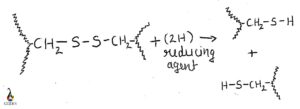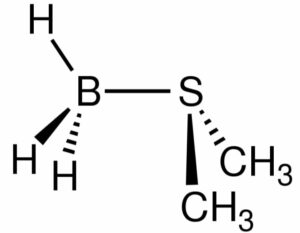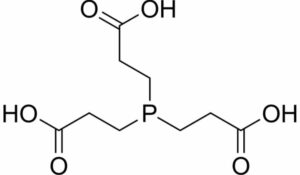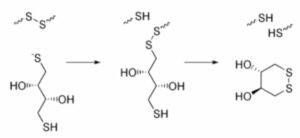There are many ways we carry out disulfide reduction but in this article we will have closer approach towards the reducing agents that are usually used.
The most common and standard reducing agents used for disulfide reduction are DTT(Dithiothreitol) and BMS(Beta-mercaptoethanol) also there are many others which are phosphine, thiol and monothiol based which will be covered in detail in the sections followed.
What is disulfide reducing agent?
Reagents that reduce the disulfide bonds (linkage by disulfur) are known as disulfide reducing agents. There are many methods by which reduction can be carried out.
How can disulfide bonds be reduced?
We know that a bond that is formed by the linking of sulfur atoms is known as a disulfide bond.
The process where the interconversion of dithiol to disulfide groups or vice versa occurs follows a redox reaction. But here in this article, we will have a closer approach towards the disulfide reduction process in detail. So, how can we achieve the process of reduction of disulfide bonds? There are many ways. We can use the reducing agents for the reduction of disulfide bonds.
What we understand by reducing agents is, it is a compound that has the potential to lose or is able to donate an electron (oxidizing agent).
All this occurs in a redox reaction. As we know disulfide bond is mostly found in proteins. In order to understand the process of disulfide reduction let us consider the example of Insulin (protein).

The tertiary structure as shown in the figure upon addition of a reducing agent causes the denaturation of the protein, (meaning it is reduced). Have a look at the figure for a better understanding.
Read more about :Disulfide Bonds Examples : Several Facts
What reduces the disulfide bonds in proteins?
There are many reducing agents involved in disulfide reduction here three categories have been discussed namely dithiol, phosphine and monothiol.
The reducing agents involving dithiol include DTT (Dithiothreitol), BMMP (bis (mercaptomethyl)) pyrazine, BMS (Borane dimethylsulfide), DMH (1, 2 – Dimethyl hydrazine), DTBA (Dithiobutylamine, and many more. The ones involving phosphines are TCEP (tris (2-carboxyethyl) phosphine), TBP (Tributylphosphine), and THPP (Tris (3-hydroxypropyl) phosphine). And the one having monothiol is β-ME (Beta-mercaptoethanol).

From the above reagents the most commonly used reducing agents for disulfide reduction are BME/ β-ME and dithiothreitol. In the further sections, we will analyze the various methods/reducing agents in detail.

Image credit : Wikipedia
Disulfide reduction methods
- Disulfide reduction using TCEP.HCl (Tris (2-carboxyethyl) hydrochloride).
This particular reducing agent is used widely in the process of disulfide reduction of various proteins (its molecular weight is said to be 286.64 g). Most often it is used as the salt of hydrochloride. (TCEP.HCl). It has the potential of reducing disulfide bonds within as well as between the proteins. It is considered as a great reducing agent as it is non-volatile (so easy to work with) and odorless.
Observed to be soluble as well as stable in most of the aqueous solutions. The solubility of TCEP.HCl (the hydrochloride salt) in water is found to be around 310g/L. The best part is due to its hydrophilic nature it is soluble in buffers (aqueous) at any/almost all pH. Talking about its solubility in the organic solvent, it’s quite low (even in ethanol, methanol).

The advantage of using TCEP is that before the sulfhydrylreactive (cross-linking) reaction it does not have to be removed and it selectively (almost completely) reduces the stable alkyl disulfides (water-soluble) at a wide range of pH. The effective pH for disulfide reduction is 1.5-9.0 and the reaction occurs in less than 4-5 min. (at r.t.).
Procedure: 10 molar equivalent of Tris (2-carboxyethyl) phosphine has to be added to a buffer which contains oligos with constant stirring (at room temperature). After mixing, the solution should be constantly stirred for at least ten minutes (at room temperature). The logic is the amount of TCEP that is used in the reduction is proportional to the reduction meaning more TCEP used faster will be reduction completed.

An important point to be noted at neutral pH, TCEP is not found to be stable in buffers of phosphate.
- Using DTT (Dithiothreitol)
DTT’s synonym is Cleland’s reagent with a molecular formula C4H10O2S2. It is considered as a standard reagent. It has a molar mass of 154.25 g/mol and in appearance, it’s a solid (white in color). Has a melting point of 43 degrees Celsius and boils at a temperature of around 120-130 degrees Celsius.
Its redox potential is around -0.33V (at a pH of 7). Dithiothreitol is observed to be unstable at normal conditions (with respect to atmosphere) hence gets oxidized, that is the reason it should be stored/kept in inert gases. Refrigeration (at about 2-8 degrees Celsius) will be better. Dithiothreitol readily dissolves in water giving out a clear solution. It is also soluble in ether, alcohol such as ethanol, chloroform, etc.

Procedure: Important point to be noted the DTT solution that is being used in the reaction should be prepared freshly in order to obtain better results and avoid error. Molar dithiothreitol stock solution should be prepared in water and add it in the buffer solution which contains the protein (that has to be reduced). Incubation is a must to obtain reduction, hence incubation for at least 25-30 minutes at around 35 degrees Celsius (higher than that will also do as reduction is better at a higher temperature).

- Using DTBA (Dithiobutylamine)
Dithiobutylamine is mostly used as the salt of HCl. It is almost odorless, solid (white in color). Dissolves in water readily. It is also soluble in alcohol like methanol but does not dissolve in chloroform. It has a chemical formula of C4H11NS2.HCl and has a molecular weight of 173.7.
Procedure: The DTBA is added to a buffer solution containing the protein to be reduced at a pH of around 7.0.
- Using THPP (Tris (3-hydroxypropyl) phosphine)
THPP is found to be soluble in water in all conditions and at all properties. It is an odorless substance. This chemical is quite easy to handle as it is quite stable and does not get oxidized easily. It has the potential to reduce various types of disulfide bonds. Most importantly it does not cause pollution meaning it falls into the category of green chemistry.
Procedure: Just like the other methods here also the THPP is added to the buffer solution containing the required protein/substance having a disulfide bond that has to be reduced. We can say this is one of the most effective methods for disulfide reduction as it is easy to operate, economically viable, and eco-friendly.
Also Read:
This is Sania Jakati from Goa. I am an aspiring chemist pursuing my post graduation in organic chemistry. I believe education is the key element that moulds you into a great human being both mentally and physically. I’m glad to be a member of scintillating branch of chemistry and will try my best to contribute whatever I can from my side and Lambdageeks is the best platform where I can share as well as gain knowledge at the same time.